MOTHER’S DAY
CULTURAL RESOURCES
Sunday, May 13, 2012
The African American Lectionary Cultural Resources Team
I. Introduction
The history of Mother’s Day in America has been well written of in past Lectionary units since 2008.
This year, through Exodus 1:22–2:10 the Lectionary highlights mothers (those with biological children and those who made communities of children theirs) who through their nurture, their wisdom, and their faith have and continue to add so much to the fabric of the country.
In our text for today, the story of how Moses is spared from death by the quick thinking of his mother and sister is our focus. Moses was facing death because of the decree by the Egyptian Pharaoh that all male children would be killed at birth. Unfortunately, the slaughter of the “innocents” continued long after Pharaoh and his government ceased to exist. But, just as there has always been those who sought to slaughter innocent children, there have always been mothers at the ready who said, “Not on my watch.” Today we salute these mothers.
II. Notable Mothers
We know the names of a few of the well-known mothers of the abolitionist movement and the Modern Civil Rights Movement: Harriet Tubman, Sojourner Truth, Ida B. Wells, Ella Baker, Fannie Lou Hamer, Rosa Parks, Mylrie Evers-Baker, Constance Baker Motley, and Coretta Scott King.
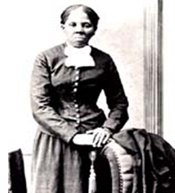 |
|
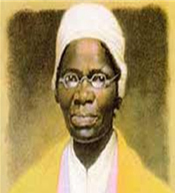 |
|
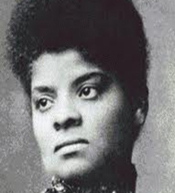 |
| Harriet Tubman |
|
Sojourner Truth |
|
Ida B. Wells |
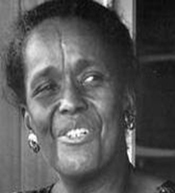 |
|
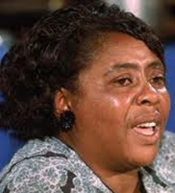 |
|
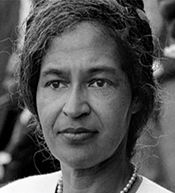 |
| Ella Baker |
|
Fannie Lou Hamer |
|
Rosa Parks |
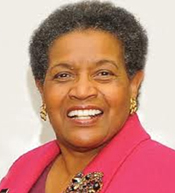 |
|
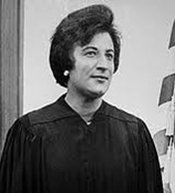 |
|
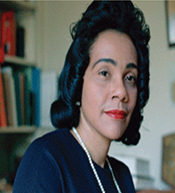 |
| Mylrie Evers-Baker |
|
Constance Baker Motley |
|
Coretta Scott King |
So today we lift the biographies of some of the lesser-known mothers of the abolitionist movement and the modern Civil Rights movement: Maria W. Stewart, Frances Ellen Watkins Harper, Septima Poinsette Clark, and Clara Luper. These early and modern mothers fought against almost insurmountable odds to help Blacks claim their constitutional rights, liberty, dignity, and opportunities too long denied them. Most did this work while also rearing their biological children, fighting sexism in the Black community and wider society and with little assistance in their efforts.
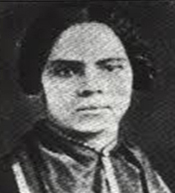
Reverend Maria W. Stewart (1803–1879)
Martha Simmons and Frank Thomas, editors of Preaching with Sacred Fire: African American Sermons from 1750 the Present, list Maria Stewart as a preacher from information gleaned about her life from a variety of sources.1 Maria Stewart was born in Hartford, Connecticut. Orphaned at age five, she was bound to the family of a preacher until age 15. She learned to read, apparently through church school and the preacher’s library. She married Thomas Stewart in 1826; they were part of Boston’s black middle class and both were friends with the radical black activist David Walker. Sadly, Stewart’s husband died only three years after they wed. White businessmen swindled her out of an inheritance that she was due from her husband.2
After the death of her husband and David Walker, Stewart became more committed to the Church and to the “cause of oppressed Africa.” She wrote that her new commitment made her a “warrior and potential martyr for the cause of oppressed Africa.”3 In 1831, Stewart wrote an article titled “Religion and the Pure Principles of Morality, the Sure Foundation on Which We Must Build.” It was published by William Lloyd Garrison and Isaac Knapp, the editors of the Liberator, an abolitionist-focused weekly newspaper. The article appeared just two months after the famous Nat Turner slave revolt in Virginia. It urged the black community to “sue for your rights and privileges” and warned whites that “our souls are fired with the . . . love of liberty and independence.”4 Stewart went on to write additional essays and poems for the Liberator.
In early 1832, Stewart began her public speaking engagements. In September 1832, she lectured at Franklin Hall for the New England Anti-Slavery Society. It was the first public lecture by an American woman to a mixed audience of men and women! In what was titled her “Farewell Address to Friends in the City of Boston” in 1833 Stewart said:
Having God for my friend and portion, what have I to fear?
As long as it is the will of God, I rejoice that I am as I am;
for man, in his best estate, is altogether vanity. Men of
eminence have mostly risen from obscurity; nor will I,
although a female of darker hew, and far more obscure
than they, bend my head or hang my harp upon the willows.5
In 1835 William Garrison published Stewart’s Productions of Mrs. Maria W. Stewart which contained the text of four of her speeches. Stewart moved to New York, where she taught at schools, and then to Washington, D.C. where she also taught and became head of housekeeping for the Freedmen’s Hospital. In 1871 she opened a school for poor children in the neighborhood. In the late 1870s Stewart self-published Meditations from the Pen of Mrs. Maria Stewart, which was a reprint of her material published by Garrison but also included sections titled “Letters,” “Commendations,” and “Sufferings During the War.”
Religion was interspersed throughout Stewart’s rhetoric. Apparently growing up in the home a clergy had an indelible impact. Her work and writings also addressed global issues such as the European uprisings of the 1830s. She also spared no pain in criticizing white oppressors, white women who oppressed black women, and blacks for doing less than they could to fight oppression. We owe so great a debt to this mother of the faith and the civil rights and women’s movement.
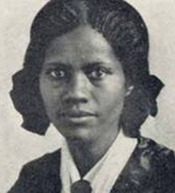
Frances Ellen Watkins Harper (1825–1911)
Of Frances Ellen Watkins Harper, one scholar said:
In an era full of extraordinary black women, Frances Watkins Harper, abolitionist and feminist, lecturer, poet and novelist, was one of the most extraordinary among them. If she had published nothing else, Iola Leroy would have been sufficient for her to claim a place among the intellectuals of her time….Harper takes us to the heart of the most complex problems that faced black Americans in the post-Civil War era, and blazes a trail toward solutions.6
Born in Baltimore, Frances was an only child. Her mother died when Frances was two. She was then reared by an aunt and attended a school run by her uncle. In 1850 Harper moved to Ohio and taught at Union Seminary, an A.M.E. school; this seminary became a part of Wilberforce University. Around 1854, Harper had begun to move around a lot and lived for a time in a station of the Underground Railroad. In August of 1954 she lectured in Boston and New Bedford, Massachusetts on “Education and the Elevation of the Colored Race.” Harper was so disturbed by the horrors of slavery that she traveled throughout New England speaking against it. The Pennsylvania Anti-Slavery society hired her. Between 1854 and 1860, she traveled extensively and usually lectured two to three times a day.7 William Still, conductor of the Underground Railroad, wrote that she was one of the most liberal contributors, as well as one of the ablest advocates for the Underground Railroad and the slave.8 In 1854 she wrote Poems on Miscellaneous Subjects. The book was wildly successful and was reprinted in 1857, 1858, 1864, and 1871. In 1859, she became the first black woman to publish a short story. She wrote several other poems and books. She wrote a novel at age sixty-seven; it was titled Iola Leroy.
Harper married in 1860 and the couple had one child. Her husband died in 1864. She began a self-financed abolitionist speaking tour in 1867. She also became a favored speaker of the women’s movement. Confronting racism in the women’s movement, Harper and colleagues Anna Julia Cooper, Fannie Jackson Coppin, Sarah Earley, Fannie Barrier Williams, and Hallie Q. Brown formed the National Association of Colored Women. Harper became its first vice-president.9
In addition to her abolitionist work and her work on behalf of black women, Harper’s poetic writings and her prose and fiction are no nonsense, political, harshly against slavery and particularly against the atrocities slavery visited upon women. If you have not read her works, her poems “The Slave Mother,” “The Auction Block,” and “Bury Me in a Free Land” are particular must-reads. The last stanza of “Bury Me in a Free Land” hauntingly says,
My rest shall be calm in any grave
Where none can call his brother a slave.
I ask no monument, proud and high,
To arrest the gaze of the passers-by;
All that my yearning spirit craves,
Is bury me not in a land of slaves.10
The poem “A Double Standard” rails against anti-womanist treatment and the privileges of male-hood. “The Slave Mother” and “Bury Me in a Free Land” are printed below in the prose and poetry section of this unit.
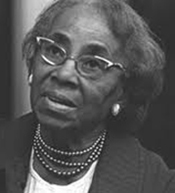
Septima Poinsette Clark (1898–1987)
Septima Poinsette Clark was born in Charleston, South Carolina; she was one of eight children of Peter and Victoria Poinsette. Mother Clark (as she has been called) developed the literacy and citizen workshops that played an important role in the drive for voting rights and civil rights for African Americans in the Civil Rights Movement. She became known as the “Queen mother” or “Grandmother of the American Civil Rights Movement” in the United States.11 She had only one son who lived to adulthood but she helped rear her grandchildren and took in and reared the children of others.
In 1919, her unequal pay as a teacher in a black school off the Johns Island Coast, compared to the white teacher who taught across the street from Clark, led her into the movement for civil rights. In 1920, she worked with the NAACP to gain the right for blacks to become principals in Charleston’s public schools.12
As part of her lifelong fight against adult illiteracy, in 1954 Clark began teaching classes in connection with the Highlander Folk School of TN. Clark and her cousin led program workshops. They taught students how to take driver’s license exams, complete voter registration forms, and how to sign checks, among other things. One of the participants in one of her workshops was Rosa Parks. A few months later, Parks helped start the Montgomery Bus Boycott.13 Mrs. Clark lost her job as a teacher in 1956 when she refused to renounce her NAACP membership. Many years later she sued and in 1976 had her pension restored by the state of North Carolina and served two terms on the Charleston School board.
Mother Clark is most famous for establishing “Citizenship Schools,” which served to teach adults throughout the south to read and write using the Highlander Folk School model.14 These schools were a response to requirements by southern states which required literacy and interpreting various portions of the US Constitution in order to be allowed to register to vote. In addition to literacy, the Citizenship Schools taught students to protest against racism. Clark agreed that it was best to place the schools under the Southern Christian Leadership Conference in 1961 after racist leaders worked to close down the site headed by Clark. The Citizenship Schools trained over 10,000 Citizenship School teachers who taught throughout the south,15 and as a result by 1970 according to Clark’s book Echo in My Soul, two million African Americans had registered to vote.16 In 1965 Dr. King insisted that Mrs. Clark accompany him to Sweden when he received the Nobel Peace Prize. He said that she deserved as much credit for the achievements of the civil rights movement as he did.17
But not only did Mother Clark fight for the rights of blacks, she was also a fierce supporter of women’s rights, beginning with her working to stop the sexism by black men against black women who worked in the civil rights movement.18 Clark said, “I see this as one of the weaknesses of the civil rights movement, the way the men looked at women…I found all over the South that whatever the man said had to be right…”19 She felt that women had played a major role in the civil rights movement and had not received much credit for their contributions.
In 1979, Mrs. Clark received the Living Legacy Award from President Carter. Her autobiography won the American Book Award in 1987.
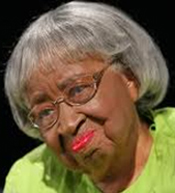
Clara Luper (1923–2011)
Clara Shepard Luper, born Clara Mae Shepard, was born in Okmulgee County, Oklahoma, the middle of five children. She was the first black student to enroll in the history department at the University of Oklahoma, where she earned a master’s degree. Luper was a civic leader, retired schoolteacher, and a pioneering leader in the modern Civil Rights Movement. Luper was arrested 26 times during sit-ins and other nonviolent protests. She also marched with Dr. King.20
Luper is best-known for her leadership role in the 1958 Oklahoma City Sit-in Movement, as the
NAACP Youth Council decided to force the issue at Oklahoma downtown eating establishments that did not serve Blacks. Luper helped establish the Youth Council of the Oklahoma City Chapter of the NAACP in the 1950s and served as its adviser for 50 years. “The youth endured cursing and threats from customers of establishments that they sought to integrate, were covered with ketchup, hot grease and spit and were kicked and punched. But Luper taught them [the youth] courage and self-respect and the non-violent philosophy of Martin Luther King Jr. She made certain that every day their clothes were clean and ironed, so they would look confident.21
On Tuesday afternoon, August 19, 1958, Luper and a group of Youth Council members entered the segregated
Katz drugstore in downtown Oklahoma City. They took seats and asked to be served. Two days later, Katz corporate management in
Kansas City desegregated its lunch counters in three states.
This successful August 1958 sit-in led by Luper, her eight-year old daughter who suggested the action, and the rest of the children in the NAACP Youth Council, at the Katz Drug Store occurred a year and a half before the February 1, 1960 Greensboro, North Carolina sit-ins. Along with the NAACP Youth Council, Luper personally integrated hundreds of restaurants, cafes, theaters, hotels, and churches, including such notable Oklahoma City establishments as the Split-T drive-in and the
Skirvin Hotel.
Luper taught high school history for 41 years in schools throughout Oklahoma City. In the 2011 article “Civil Rights Leader Clara Luper Has Died,” the following story was shared:
As a 16-year-old, Joyce Henderson , a soon-to-be senior at Dunjee High School, heard the Rev. Martin Luther King Jr. present his “I Have a Dream” speech Aug. 28, 1963. With a little cash in her purse and a change of clothes in a small suitcase, Henderson boarded one of two charter buses with fellow students active in the NAACP Youth Council. One of her teachers, Clara Luper, invited her to make the trip to Washington .
Last Friday and again Monday, Henderson went by to see Luper. On Friday, “I said, ‘Mother Luper, this is Joyce.’ She nodded her head; she knew who I was.” Henderson, though not in on the initial sit-in, became involved in the movement. She said Luper’s students at Dunjee would call her “Ms. Luper.” “As we’ve grown older many of us began calling her Mother Luper,” she said. “She was truly that. For whatever reason she made each of us feel special, like she was our mother.”
Henderson always felt a sense of security knowing of Luper’s presence in the world, she said. That made Thursday a sad day for Henderson, who retired in 2006 after 36 years as an educator and administrator. “You’ve got to admit that Oklahoma and this world is a better place because of Mother Luper.”22
Luper continued desegregating hundreds of establishments in Oklahoma, and was active on the national level during the 1960s movements. She took part in the 1963 March on Washington and also took part in the 1965 Selma to Montgomery marches, where she received a deep cut in her leg on “Bloody Sunday” when 600 civil rights marchers were attacked by state and local police with tear gas and billy clubs.
In August 1969, Luper was the spokesperson for striking sanitation workers in Oklahoma City. The sanitation workers sought a shorter work week, pay raises, and new grievance procedures. The Oklahoma City sanitation strike lasted three months and the sanitation workers prevailed in many of the rights they sought.
In 1972 Clara Luper ran unsuccessfully for election to the United States Senate. The Clara Luper Corridor, a multi-million dollar two-mile streetscape project connecting the Oklahoma State Capitol complex with the historically African American area of Northeast Oklahoma City, was opened in 2006.
Luper received hundreds of awards in her lifetime, and the Clara Luper Scholarship, a full scholarship given by Oklahoma City University , has been awarded to 30–45 students every year for the past decade. The scholarship is geared toward students who are minorities, come from underserved high schools, or from households with lower incomes.
Clara Luper’s book Behold the Walls (1979) is an acclaimed first-hand account of the campaign for civil rights in Oklahoma City during the 1960s.
III. Poetry and Prose
This poem by Frances Ellen Harper is the conclusion to her book, Iola Leroy.
There is light beyond the darkness,
Joy beyond the present pain;
There is hope in God’s great justice
and the Negro’s rising brain.
Though the morning seems to linger
over the hill-tops far away,
Yet the shadow bears the promise
of a brighter coming day.
“Bury Me in a Free Land,” also by Harper, is her most well-known poem.
Bury Me in a Free Land
MAKE me a grave where’er you will,
In a lowly plain, or a lofty hill;
Make it among earth’s humblest graves,
but not in a land where men are slaves.
I could not rest if around my grave
I heard the steps of a trembling slave;
His shadow above my silent tomb
would make it a place of fearful gloom.
I could not rest if I heard the tread
of a coffle gang to the shambles led,
And the mother’s shriek of wild despair
rise like a curse on the trembling air.
I could not sleep if I saw the lash
Drinking her blood at each fearful gash,
And I saw her babes torn from her breast,
like trembling doves from their parent nest.
I’d shudder and start if I heard the bay
of bloodhounds seizing their human prey,
And I heard the captive plead in vain
as they bound afresh his galling chain.
If I saw young girls from their mother’s arms
Bartered and sold for their youthful charms,
My eye would flash with a mournful flame,
My death-paled cheek grow red with shame.
I would sleep, dear friends, where bloated might
can rob no man of his dearest right;
My rest shall be calm in any grave
Where none can call his brother a slave.
I ask no monument, proud and high,
to arrest the gaze of the passers-by;
All that my yearning spirit craves,
Is bury me not in a land of slaves.23
This final poem by Harper is poignant and provocative. It clearly shows her connection to women that made her such a fierce women’s right advocate and abolitionist.
The Slave Mother
Heard you that shriek? It rose
So wildly on the air,
It seem’d as if a burden’d heart
was breaking in despair.
Saw you those hands so sadly clasped—
The bowed and feeble head—
The shuddering of that fragile form—
that look of grief and dread?
Saw you the sad, imploring eye?
Its every glance was pain,
As if a storm of agony
were sweeping through the brain.
She is a mother pale with fear,
Her boy clings to her side,
And in her kyrtle vainly tries
his trembling form to hide.
He is not hers, although she bore
For him a mother’s pains;
He is not hers, although her blood
is coursing through his veins!
He is not hers, for cruel hands
May rudely tear apart
The only wreath of household love
that binds her breaking heart.
His love has been a joyous light
That o’er her pathway smiled,
A fountain gushing ever new,
amid life’s desert wild.
His lightest word has been a tone
of music round her heart,
Their lives a streamlet bent in one—
Oh, Father! must they part?24
IV. Making Mother’s Day Memorable in Your Church and Home
- 5 WAYS MEMENTOES
At least four Sundays before Mother’s Day, ask all of your members to celebrate their mothers by creating 5 WAYS Mementoes.
Explanation: 5 WAYS Mementoes are poems, books, photo albums, videos, or songs produced by men and women in which they tell their mothers (biological or not) living or deceased, 5 WAYS that she has helped them be a better person. Each of the 5 WAYS should be accompanied by some visual aid, a song, or other accompaniment. For instance if one of the ways that your mother helped make you a better person was by teaching you to love Scripture, that could be turned into one of your five way mementoes as follows:
5 WAYS Video Memento -
1. One way that my mother helped make me a better person is teaching me to love Scripture.
This statement could be followed on the video by images of your mother reading the Bible to you, images of you as a young child reading the Bible in church, images of you reading the Bible to your children, images of you holding the Bible, an article you may have written about Scripture, or if you are a preacher, images of a sermon you wrote and or a video of you preaching. If you are a church school teacher, you could include images of you with your class. All of the images would go in the first of your 5 WAYS sections.
2. Your church could then provide a table display of some of the 5 WAYS Mementoes that are produced by members. Be sure to have children and youth participate in the project. This is a great project for Sabbath and Sunday school classes.
V. Songs for Mother’s Day
Every Day Is Like Mother’s Day
Every day feels like Mother’s May
She is with me in my heart
I can often hear…hear my mother’s voice
We will never ever be apart
(repeat)
Verse
I never can forget on Christmas morning
When my family would all gather around our house
Mama would sit over there in her big old rocking chair
She would speak so softly and so kind yeah yeah yes
Lord I thank you I thank you for all my children
Every one of them yes you gave each one of them to me
So I try to be a very good mother
I even forgot…I forgot all about my needs
Every day feels like Mother’s Day
She is with me in my heart
I can often hear…hear my mother’s voice
We will never ever be apart
She gave me my start (gave me my start)
I’m gonna keep her in my heart (here to my heart)
My love for my mother (it will never depart)
Mama showed me the right way (showed me the way)
By the path that she laid (by the path she laid)
I think about my mother (every day)
Mama gave me her love (gave me her love)
Then when she went on to glory on the wings (wings of a dove)
Now she’s looking down on me (from up above)
She’s looking down on me
Every day feels like Mother’s Day
She is with me in my heart
I can often hear…hear my mother’s voice
We will never ever be apart.25
I Remember Mama
I remember mama,
And the love that she gave
Kneeling by her bed side
I can still hear mama say,
“The people are depending on you, Shirley,
Don’t you let them down”
I remember mama in a happy way
We went to school with holes in our shoes
We didn’t have much but the Lord saw us through
Mama kept the family together
I remember mama in a happy way
She packed our lunch in an old greasy bag
It might’ve seemed empty,
But it was more than others had
It had a lot of love way down deep inside and
I remember mama in a happy way
Now mama is sleeping in the bosom of Jesus Christ
Somehow I know she’s smiling, she’s smiling on us right now
One day I’ll see her again, how happy I will be
And I remember mama in a happy way
My brothers and sisters, they’re living far apart
Although my mama’s gone, she’s right here in our hearts
We’re all gonna pull together and stay in the holy place
I remember mama in a happy way
I remember mama, I remember mama in a happy way.26
Mama/I Thought You’d Like to Know 
Mama I thought you’d like to know
all those nights you paced the floor
praying that I would make it home alright,
believing in God that He would someday save my soul
well He did, just thought you’d like to know.
Then I thought you’d like to know
all those prayers you prayed for me,
never a-one fell to the ground, I know
sometimes it looked like I was a million miles from Grace
but He answered your prayers, just thought you’d like to know.
Chorus
Oh Momma I want you to know I love you,
please forgive me for all the times I broke your heart
every tear you cried for me, drew me closer to being free,
And I want to thank you,
Just thought you’d like to know.
Then I thought you’d like to Know
that I wish I could live my life again,
if I could, I would surely make amends,
And if I could help my Brother, a new life to discover, Oh I would,
just thought you’d like to know.27
VI. Books
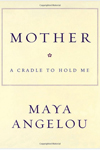 |
Angelou, Maya. Mother: A Cradle to Hold Me. New York, NY: Random House, 2006.
|
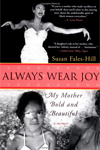 |
Fales-Hall, Susan. Always Wear Joy: My Mother Bold and Beautiful. New York, NY: HarperCollins, 2004. |
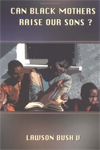 |
Bush, Lawson. Can Black Mothers Raise Our Sons? Chicago: African American Images/IPG Press, 1999. |
Notes
1. According to Simmons, the sources used to determine that Stewart was a preacher were: Maria W. Stewart’s book, The Mediations from the Pen of Mrs. Maria W. Stewart, 1879, reprinted in Marilyn Richardson’s Maria W. Stewart, America’s First Black Woman Political Writer: Essays and Speeches. Bloomington: Indiana University Press, 1987; James Bert Lowenberg and Ruth Bogin, eds., Black Women in Nineteenth Century American Life. University Park: Pennsylvania State University Press, 1991; and Clarice Martin’s “Biblical Theodicy and Black Women’s Spiritual Autobiography: ‘The Miry Bog, The Desolate Pit, A New Song in My Mouth,’” in A Troubling in My Soul. Emilie Townes, ed. Maryknoll, NY: Orbis Books, 1993.
2. Notable Black American Women. Jessie Carney Smith, ed. Detroit: Gale Research, 1992. p. 1083.
3. Richardson, Marilyn. Maria W. Stewart, America’s First Black Woman Political Writer: Essays and Speeches. Bloomington: Indiana University Press, 1987. p. 8.
4. Lowenberg, James Bert, and Ruth Bogin, eds., Black Women in Nineteenth Century American Life. University Park: Pennsylvania State University Press, 1991. pp.189–91.
5. Ibid., 200.
6. Notable Black American Women. p. 458.
7. Ibid.
8. Still, William. Introduction to the second edition, Iola Leroy. Philadelphia: Garigues Brothers, 1892. p. 755.
9. Notable Black American Women. p. 458.
10. Harper, Frances Ellen. “Bury Me in a Free Land.” Online location: http://www.theotherpages.org/poems/2001/harper0105.html accessed 5 February 2012
11. Olson, Lynne. Freedom’s Daughters: The Unsung Heroines of the Civil Rights Movement from 1830 to 1970. New York, NY: Simon and Schuster, 2002.
12. Online location: www.wikipedia.org/windex.php?title=Septima_Poinsette_Clark accessed 5 February 2012
13. Ibid.
14. Payne, Charles M. I’ve Got the Light of Freedom: The Organizing Tradition and the Mississippi Freedom Struggle. Berkeley, CA: University of California Press, 1997.
15. Ibid.
16. Clark, Septima. Echo in My Soul. New York, NY: Dutton Publishers/Penguin, 1962. p. 135.
17. Online location: http://www.usca.edu/aasc/clark.htm
18. See Itabari Njeri. “Educator Chronicles Her Civil Rights Role.” Charlotte Observer (June 15, 1987: IA, 4A) and Grace Jordan McFadden, “Septima P. Clark and the Struggle for Human Rights” in Women in the Civil Rights Movement, Trailblazers and Torchbearers, 1941–1965. Vicki L. Crawford, Jacqueline Anne Rouse, and Barbara Woods, eds. Brooklyn, NY: Carlson Publishing, Inc., 1990. pp. 85–97.
19. Clark, Septima Poinsette. Ready from Within: Septima Clark and the Civil Rights Movement, A First Person Narrative. Wild Tree Press, 1986. pp.79–80.
20. Online location: http://newsok.com/civil-rights-leader-clara-luper-has-died/article/3575634 accessed 5 February, 2012. See also Davis D. Joyce, ed., An Oklahoma I Had Never Seen Before: Alternative Views of Oklahoma History. Norman, OK: University of Oklahoma Press, 1994 and Linda Williams Reese, “Clara Luper and the Civil Rights Movement in Oklahoma City, 1958–1964” in African American Women Confront the West, 1600–2000. Norman, OK: University of Oklahoma Press, 2003.
21. Medley, Robert and Bryan Painter. “Civil Rights Leader Clara Luper Has Died,” June 9, 2011. Online location: http://newsok.com/civil-rights-leader-clara-luper-has-died/article/3575634#ixzz1no60tiT9 accessed 5 February 2012
22. Ibid.
23. Harper, Frances Ellen Watkins. “Bury Me in a Free Land.” Online location: http://www.theotherpages.org/poems/2001/harper0105.html accessed 5 February 2012
24. Harper, Frances Ellen Watkins. “The Slave Mother.” Online location: http://www.theotherpages.org/poems/2001/harper0105.html accessed 5 February 2012
25. Caesar, Shirley. “Every Day Is Like Mother’s Day.” Online location: http://www.music-lyrics-gospel.com/gospel_music_lyrics/everyday_is_like_mothers_day_13638.asp accessed 5 February 2011
26. Caesar, Shirley. “I Remember Mama.” I Remember Mama. New York, NY: Sony Records, 1992.
27. Staton, Candi. “Mama, I Thought You’d Like to Know.” Candi Staton: Here’s a Blessing for You. Los Angeles, CA: Light Year Records, 2000.
|